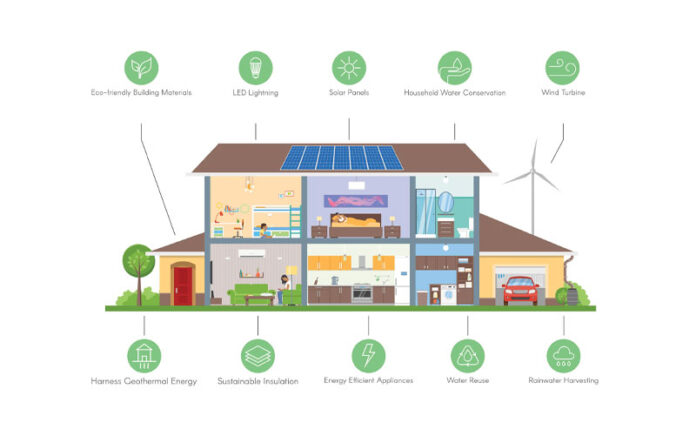Sustainability is not just a buzzword; it’s a way of life. When it comes to home design, incorporating sustainable practices is like planting a tree. You invest a little time and effort now, and in the future, you reap the benefits. From energy-efficient appliances to eco-friendly building materials, sustainable home design is the key to creating a greener and healthier living space for you and the planet.
The Benefits of Sustainable Home Design
- Cost-Effectiveness: Sustainable homes are not only good for the environment but also your wallet. By using energy-efficient appliances and incorporating passive solar design, you can significantly reduce your energy bills.
- Environmental Impact: Traditional homes are a significant contributor to carbon emissions. On the other hand, sustainable homes minimize their impact on the environment by using renewable energy sources and reducing waste.
- Health and Well-being: Sustainable home design focuses on creating a healthy indoor environment by using non-toxic materials, improving air quality, and maximizing natural light, which can have a positive impact on your well-being.
Key Elements of Sustainable Home Design
- Energy Efficiency: This includes using energy-efficient appliances, proper insulation, and incorporating passive solar design to reduce the home’s energy consumption.
- Water Conservation: Implementing water-saving fixtures, rainwater harvesting systems, and drought-resistant landscaping can significantly reduce water usage in a sustainable home.
- Material Selection: Opting for eco-friendly and recycled materials, such as bamboo flooring, reclaimed wood, and low-VOC paints, is crucial in sustainable home design.
- Waste Reduction: Sustainable home design aims to minimize construction waste and promote recycling and reusing materials whenever possible.
The Role of Technology in Sustainable Home Design
Technology is playing a pivotal role in advancing sustainable home design. From smart thermostats that optimize energy usage to solar panels and home battery systems that enable homeowners to generate and store their clean energy, technological innovations are making sustainable living more accessible and convenient.
Challenges to Implementing Sustainable Home Design
Implementing sustainable home design comes with several challenges, which can range from higher costs to regulatory risks. Some of the key challenges include:
- Higher Costs: Sustainable building processes and materials often come with higher initial costs, which can deter developers despite the long-term benefits.
- Regulatory Risks and Compliance Challenges: Stringent environmental standards and building codes can lead to non-compliance risks, substantial fines, and legal consequences.
- Limited Availability of Sustainable Materials: Sustainable materials are often more expensive and less durable than traditional ones, making it challenging for architects and builders to incorporate them into their projects.
- Guarantees and Warranties: Ensuring the performance and longevity of sustainable features can be a challenge, leading to potential nonperformance of maintenance and warranty issues.
- Scope Creep and Budgets: Green projects can be susceptible to scope creep, leading to increased time and costs, impacting the project’s overall performance.
These challenges highlight the complexities involved in sustainable home design and the need to address them to create truly sustainable living spaces.
Overcome the Cost Challenges
To overcome the cost challenges of sustainable home design, consider the following strategies:
- Set Sustainability Goals: Establishing clear sustainability goals can help you prioritize and focus on the most important aspects of sustainable home design, ensuring that you are making the most of your budget.
- Invest in Energy-Efficient Appliances and Systems: While the upfront costs of energy-efficient appliances and systems may be higher, they can significantly reduce your long-term energy consumption and operational costs.
- Opt for Sustainable Materials: Although sustainable materials may be more expensive initially, they can provide long-term cost savings and environmental benefits.
- Maximize Natural Light and Ventilation: By incorporating natural light and ventilation into your home design, you can reduce the need for artificial lighting and heating/cooling systems, which can help lower your energy bills.
- Consider Passive Solar Design: Utilizing passive solar design techniques can help reduce your home’s energy consumption by harnessing the sun’s energy for heating and cooling.
- Incorporate Renewable Energy Sources: Installing solar panels or other renewable energy systems can help offset your energy consumption and reduce your reliance on traditional energy sources.
- Implement Water-Saving Technologies: Rainwater harvesting systems and water-saving fixtures can help reduce your water consumption and lower your water bills.
- Seek Government Incentives and Tax Credits: Many governments offer incentives and tax credits for sustainable home design, which can help offset the initial costs of implementing sustainable features.
- Collaborate with Sustainable Home Builders: Partnering with a sustainable home builder can help you navigate the complexities of sustainable home design and ensure that your project stays within budget.
- Educate Yourself: Stay informed about the latest sustainable home design trends and technologies to make informed decisions and take advantage of cost-saving opportunities.
By implementing these strategies, you can create a sustainable home design that not only benefits the environment but also provides long-term cost savings and a healthier living space for you and your family.
The Future is Now
As we look to the future, sustainable home design is set to become the new standard. With a growing awareness of environmental issues and an increasing demand for eco-friendly living spaces, the future of home design is undeniably green. By embracing sustainable practices today, we can create a better tomorrow for generations to come.
Conclusion
Sustainable home design is not just a trend; it’s a necessity. By integrating energy efficiency, water conservation, eco-friendly materials, and technological innovations, we can build homes that are not only better for the planet but also for the people who inhabit them. So, why not take the first step towards a greener future and consider sustainable home design for your next abode?
FAQs
What are the key ideas behind sustainable home finance?
Sustainable home finance aims to promote lower emissions, better EPC (Energy Performance Certificate) ratings, improved home valuation, lower energy costs, and preferable interest rates and loan values.
What are the benefits of sustainable home finance for mortgage lenders and customers?
Mortgage lenders see potential benefits in terms of reducing risk, while customers can take advantage of lower rates, higher loans, or cashback deals. Additionally, sustainable properties are becoming more desirable, leading to a virtuous circle of attractiveness.
Where can homeowners find sustainable home finance options?
Homeowners can explore options from mortgage lenders, green bonds, energy-efficient financing, federal and state programs, and specialized sustainable home finance providers like GoodLeap.
Are shipping container homes sustainable?
Shipping container homes is not considered sustainable due to reasons such as premature recycling, inefficient recycling, remnant toxins, and the use of COR-TEN steel, which can have environmental implications.
How can I get financing for a shipping container home?
Financing for shipping container homes can be challenging, as lending institutions are often reluctant to take on the risks associated with alternative homes. Seeking advice from established builders and exploring viable options is recommended.








